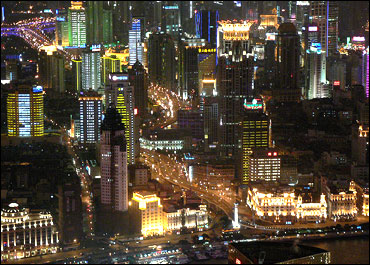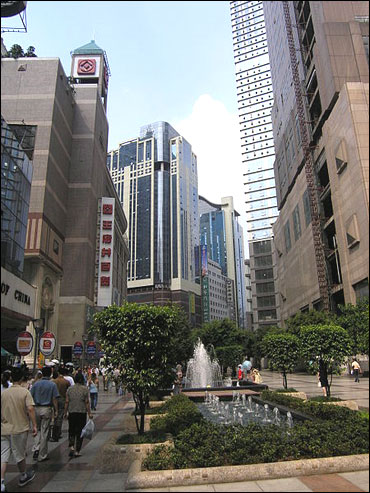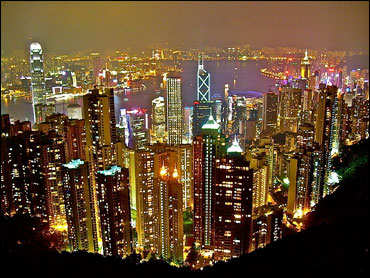 | « Back to article | Print this article |
Delhi, Mumbai among world's richest cities in 2025
A recent study published by the McKinsey Global Institute says that half of the world's population already lives in cities and generates more than 80 per cent of the world's GDP.
Interestingly, the report points out that only 600 urban centres, with a fifth of the world's population, generate 60 per cent of global GDP.
Another 14 years down the line, that is by 2025, while 600 cities will still account for 60 per cent global GDP, the cities themselves will change, not to mention the rankings.
Some of the cities in the 2011 list will no more be there and new cities -- mostly from India, China and Latin America will either be added to the list or will improve their rankings.
So which will be the 25 richest cities in 2025?
Click on NEXT to find out . . .
Delhi, Mumbai among world's richest cities in 2025
Rank 1: Shanghai
By 2025, McKinsey says, 136 new cities are likely to enter the top 600. While all of them will be from the developing world, as many as 100 cities will be from China alone.
Shanghai, the most populous city in China, was once a fishing and textiles town.
In 1990, the economic reforms introduced by Deng Xiaoping catapulted the city in to the world economic map and the city is today one of the world's major financial centres.
In 2010, Shanghai's total GDP grew to RMB 1.687 trillion ($256.3 billion) with GDP per capita of RMB 76,000 ($11,540).
The three largest industries are financial services, retail, and real estate.
The manufacturing and agricultural sectors accounted for 39.9 per cent and 0.7 per cent of the total output, respectively.
Click on NEXT to read more...
Delhi, Mumbai among world's richest cities in 2025
Rank 2: Beijing
Finance is one of the most important sectors for Beijing.
In 2010, Beijing's nominal GDP reached RMB 1.37 trillion. Its per capita GDP was RMB 78,194 RMB.
Beijing's real estate and automobile sectors have continued to boom in recent years.
The Beijing CBD, centered at the Guomao area, has been identified as the city's new central business district and is home to a variety of corporate regional headquarters, shopping precincts and high-end housing complexes.
Beijing is increasingly becoming known for its innovative entrepreneurs and high-growth start-ups.
Click on NEXT to read more...
Delhi, Mumbai among world's richest cities in 2025
Rank 3: New York
While cities in the emerging economies will contribute heftily to the world's GDP, the McKinsey report says, 98 rapidly growing North American cities will contribute almost 10 per cent of global growth in the next 15 years.
New York is a global hub of international business and commerce and is one of three 'command centres' for the world economy.
Many major corporations are headquartered in New York City, including 42 Fortune 500 companies.
Real estate is a major force in the city's economy, as the total value of all New York City property was $802.4 billion in 2006.
The city's television and film industry is the second largest in the United States after Hollywood.
Click on NEXT to read more...
Delhi, Mumbai among world's richest cities in 2025
Rank 4: Tianjin
Tianjin is a metropolis in north China and one of the five national central cities.
The nominal GDP for Tianjin was yuan 750 billion ($110 billion) in 2009.
In 2009, per capita GDP was yuan 62,403 ($9,136).
The manufacturing sector was the largest and fastest-growing sector of Tianjin's economy.
Farmland takes up about 40 per cent of Tianjin Municipality's total area. Wheat, rice, and maize are the most important crops. Fishing is important along the coast.
Major industries include petrochemical industries, textiles, car manufacturing, mechanical industries, and metalworking.
Tianjin Binhai New Area CBD.
Click on NEXT to read more...
Delhi, Mumbai among world's richest cities in 2025
Rank 5: Chongqing
Chongqing is a major city in southwest China.
An important industrial area, Chongqing is also rapidly urbanising.
Statistics suggest that new construction added approximately 137,000 square meters (1.5 million square feet) daily of usable floor space to satisfy demands for residential, commercial and factory space.
In addition, more than 1,300 people moved into the city daily, adding almost yuan 100 million yuan ($15 million) to the local economy.
Chongqing is China's third largest centre of motor vehicle production and the largest for motorcycles.
The city's nominal GDP in 2009 reached yuan 652.8 billion ($95.5 billion).
Click on NEXT to read more...
Delhi, Mumbai among world's richest cities in 2025
Rank 6: Shenzhen
Shenzhen is a major city in the Guangdong Province, situated immediately north of Hong Kong.
Shenzhen's novel and modern cityscape is the result of the vibrant economy made possible by rapid foreign investment.
One of the fastest growing cities in the world, it is home to the Shenzhen Stock Exchange as well as the headquarters of numerous high-tech companies.
Shenzhen is also the third busiest container port in China, ranking only after Shanghai and Hong Kong.
Click on NEXT to read more...
Delhi, Mumbai among world's richest cities in 2025
Rank 7: Guangzhou
Guangzhou is the third-largest city in China.
In 2008 Guangzhou was identified as a Beta World City by the Global city index produced by GaWC.
Guangzhou is the main manufacturing hub of the Pearl River Delta, one of mainland China's leading commercial and manufacturing regions.
In 2009, the GDP reached $133.5 billion, per capita was $13,111.
Click on NEXT to read more...
Delhi, Mumbai among world's richest cities in 2025
Rank 8: Nanjing
Nanjing is the capital of Jiangsu province, China.
Located in the lower Yangtze River drainage basin and Yangtze River Delta economic zone, Nanjing has always been one of China's most important cities.
Nanjing is the second largest commercial center in the East China region, after Shanghai.
Click on NEXT to read more...
Delhi, Mumbai among world's richest cities in 2025
Rank 9: Hangzhou
Hangzhou's economy has rapidly developed.
It is an industrial city with many diverse sectors such as in light industry, agriculture, textile.
It is also considered an important manufacturing base and logistics hub for coastal China.
Click on NEXT to read more...
Delhi, Mumbai among world's richest cities in 2025
Rank 10: Chengdu
The main industries in Chengdu -- which include food, medicine, machinery and information technology -- are supported by numerous large-scale enterprises.
Many high-tech enterprises from outside Chengdu are also beginning to settle down there.
Chengdu is becoming one of the favorite cities for investment in western China.
Among the world's 500 largest companies, 133 multinational enterprises have subsidiaries or branch offices in Chengdu.
Click on NEXT to read more...
Delhi, Mumbai among world's richest cities in 2025
Rank 11: Wuhan
Wuhan is an important center for economy, trade, finance, transportation, information technology, and education in Central China.
Its major industries includes optic-electronic, automobile manufacturing, steel manufacturing, new pharmaceutical sector, biology engineering, new materials industry and environmental protection.
Click on NEXT to read more...
Delhi, Mumbai among world's richest cities in 2025
Rank 12: London
London generates approximately 20 per cent of the United Kingdom's GDP.
It is one of the pre-eminent financial centres of the world and vies with New York City as the most important location for international finance.
London's largest industry is finance, and its financial exports make it a large contributor to the UK's balance of payments.
More than half of the UK's top 100 listed companies (the FTSE 100) and over 100 of Europe's 500 largest companies are headquartered in Central London.
Along with professional services, media companies are concentrated in London.
London has five major business districts: the City, Westminster, Canary Wharf, Camden & Islington and Lambeth & Southwark.
Click on NEXT to read more...
Delhi, Mumbai among world's richest cities in 2025
Rank 13: Los Angeles
The economy of Los Angeles is driven by international trade, entertainment (television, motion pictures, video games, recorded music), aerospace, technology, petroleum, fashion, apparel, and tourism.
Los Angeles is also the largest manufacturing center in the western United States.
The city is home to seven Fortune 500 companies.
The University of Southern California (USC) is the city's largest private sector employer and contributes $4 billion annually to the local economy.
Click on NEXT to read more...
Delhi, Mumbai among world's richest cities in 2025
Rank 14: Foshan
Following Shenzhen and Guangzhou, Foshan is the third largest manufacturing base in the Pearl River Delta.
Once home to a strong state-owned enterprises sector, its current economic strength lies in privates firms.
Click on NEXT to read more...
Delhi, Mumbai among world's richest cities in 2025
Rank 15: Taipei
Taipei has been at the center of rapid economic development in Taiwan and has now become one of the global cities in the production of high technology and components.
Taiwan is now a creditor economy, holding one of the world's largest foreign exchange reserves of over $352 billion as of February 2010.
Taipei and its environs have long been the foremost industrial area of Taiwan.
Most of the country's important factories producing textiles and apparel are located there.
Click on NEXT to read more...
Delhi, Mumbai among world's richest cities in 2025
Rank 16: New Delhi
New Delhi is one of the fastest growing cities in the world and has a total population of nearly 14 million residents. It is one of the world's top global cities.
In a report jointly prepared by Institute for Competitiveness and Confederation of Indian Industry, the city is listed as the best to live in.
According to Mercer, New Delhi is the most expensive city in India for expatriates in terms of cost of living.
Click on NEXT to read more...
Delhi, Mumbai among world's richest cities in 2025
Rank 17: Moscow
Moscow is one of largest city economies in Europe and it comprises approximately 24 per cent of Russian GDP.
It has the lowest unemployment rate of all federal subjects of Russia, standing at just one per cent in 2010, compared to the national average of 7 per cent.
The average monthly wage in the city is rouble 41,600 ( 1,070), which is almost twice the national average of rouble 21,800 ( 560), and the fourth highest among the federal subjects of Russia.
Moscow is the undisputed financial centre of Russia and home to the country's largest banks and many of its largest companies.
Moscow accounts for 17 per cent of retail sales in Russia and for 13 per cent of all construction activity.
Image: Top: Spasskaya Clocktower, St. Basil's Cathedral. Centre: Cathedral of Christ the Saviour, Ostankino Tower, Monument to Yuri Dolgoruki, Kotelnicheskaya Embankment Building, House on Embankment by Boris Iofan. Bottom: Moscow International Business Center.
Click on NEXT to read more...
Delhi, Mumbai among world's richest cities in 2025
Rank 18: Singapore
Singapore has a highly developed market-based economy.
Along with Hong Kong, South Korea and Taiwan, Singapore is one of the Four Asian Tigers.
The economy depends heavily on exports and refining imported goods, especially in manufacturing.
Singapore has one of the busiest ports in the world and is the world's fourth largest foreign-exchange trading centre after London, New York and Tokyo.
The World Bank ranks Singapore as the world's top logistics hub.
Most work in Singapore is in the service sector, which employed around 2,151,400 people out of 3,102,500 jobs in December 2010.
Click on NEXT to read more...
Delhi, Mumbai among world's richest cities in 2025
Rank 19: Sao Paulo
Once a city with a strong industrial character, Sao Paulo's economy has become increasingly based on the tertiary sector, focusing on services and businesses.
The city is also unique among Brazilian cities for its large number of foreign corporations.
The city has 1,500 bank branches. There are 70 shopping malls. Sixty-three per cent of all the international companies with business in Brazil have their head offices in Sao Paulo.
The Sao Paulo Stock Exchange (BM&F Bovespa) is Brazil's official stock and bonds exchange.
Click on NEXT to read more...
Delhi, Mumbai among world's richest cities in 2025
Rank 20: Tokyo
Tokyo is one of the three world finance 'command centres', along with New York City and London.
It houses the headquarters of several of the world's largest investment banks and insurance companies, and serves as a hub for Japan's transportation, publishing, and broadcasting industries.
Tourism in Tokyo is also a contributor to the economy.
Click on NEXT to read more...
Delhi, Mumbai among world's richest cities in 2025
Rank 21: Shenyang
Shenyang is an important industrial centre in China.
It has focused on heavy industry, particularly aerospace, machine tools, heavy equipment and defence, and recently on software, automotive and electronics.
Meanwhile, the services sector - especially banking - has been developing in Shenyang.
Click on NEXT to read more...
Delhi, Mumbai among world's richest cities in 2025
Rank 22: Xi'an
Xi'an, as a second-tier city in China after the likes of Beijing and Shanghai, has a track record in the business process outsourcing field. The local government is using tax and other incentives to encourage companies and professionals to relocate there.
The growing economy of Xi'an supports the development of a software industry, and the city is a pioneer in software industry in China.
Click on NEXT to read more...
Delhi, Mumbai among world's richest cities in 2025
Rank 23: Dongguan
While the city is the third largest exporting region in China, behind Shanghai and Shenzhen (and a major centre for Taiwanese investment), outside of China, Dongguan has yet to earn ab ig name for itself.
However, its industrial restructuring has already enhanced the city's capability of independent innovation and the quantity of patent applications.
Click on NEXT to read more...
Delhi, Mumbai among world's richest cities in 2025
Rank 24: Mumbai
Mumbai is India's largest city (by population) and is the financial and commercial capital of the country as it generates 6.16 per cent of the total GDP.
It serves as an economic hub of India, contributing 10 per cent of factory employment, 25 per cent of industrial output, 33 per cent of income tax collections, 60 per cent of customs duty collections, 20 per cent of central excise tax collections, and 40 per cent of India's foreign trade.
State and central government employees make up a large percentage of the city's workforce.
Mumbai also has a large unskilled and semi-skilled self employed population, who primarily earn their livelihood as hawkers, taxi drivers, mechanics and other such blue collar professions.
The port and shipping industry is well established, with Mumbai port being one of the oldest and most significant ports in India.
Click on NEXT to read more...
Delhi, Mumbai among world's richest cities in 2025
Rank 25: Hong Kong
As one of the world's leading international financial centres, Hong Kong has a major capitalist service economy characterised by low taxation and free trade, and the currency, Hong Kong dollar, is the ninth most traded currency in the world.
As of 2010, Hong Kong is the eighth most expensive city for expatriates, falling from fifth position in the previous year.
In 2011, Hong Kong was ranked second in the Ease of Doing Business Index, behind Singapore.

























